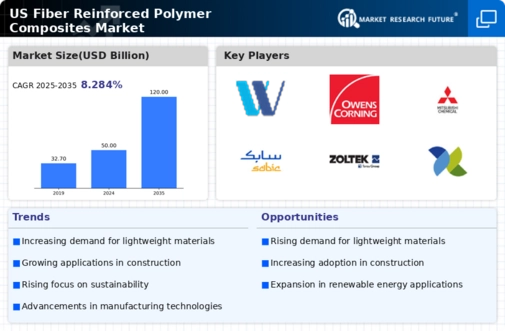The fiber reinforced polymer composites market is characterized by a dynamic competitive landscape, driven by increasing demand across various sectors such as automotive, aerospace, and construction. Key players are actively pursuing strategies that emphasize innovation, sustainability, and regional expansion to enhance their market positions. For instance, in November 2025, Hexcel Corporation (US) announced a new partnership with a leading aerospace manufacturer to develop advanced composite materials aimed at reducing weight and improving fuel efficiency in aircraft. This move underscores Hexcel's commitment to innovation and positions it favorably in a market that increasingly prioritizes sustainability.
The competitive structure of the market appears moderately fragmented, with several key players vying for market share. Companies are adopting various business tactics, such as localizing manufacturing and optimizing supply chains, to enhance operational efficiency and responsiveness to market demands. This collective approach not only strengthens their competitive edge but also fosters a collaborative environment where innovation can thrive.
In October 2025, Toray Industries Inc. (US) unveiled a new production facility dedicated to the manufacturing of high-performance carbon fiber composites. This strategic investment is expected to bolster Toray's production capacity and meet the growing demand from the automotive sector, which is increasingly shifting towards lightweight materials to improve fuel efficiency. The establishment of this facility reflects Toray's proactive stance in addressing market needs and enhancing its competitive positioning.
In September 2025, Owens Corning (US) launched a new line of sustainable fiberglass composites designed for use in construction applications. This initiative aligns with the growing trend towards environmentally friendly materials and positions Owens Corning as a leader in sustainability within the fiber reinforced polymer composites market. The introduction of these products not only caters to evolving consumer preferences but also enhances the company's brand reputation in a competitive landscape.
Furthermore, in August 2025, BASF SE (US) announced a collaboration with a technology firm to integrate AI-driven analytics into its manufacturing processes. This strategic move aims to optimize production efficiency and reduce waste, reflecting a broader trend towards digital transformation in the industry. By leveraging advanced technologies, BASF is likely to enhance its operational capabilities and maintain a competitive edge in a rapidly evolving market.
As of December 2025, the competitive trends shaping the fiber reinforced polymer composites market include a strong emphasis on digitalization, sustainability, and technological integration. Strategic alliances are increasingly becoming a cornerstone of competitive differentiation, enabling companies to pool resources and expertise. The market appears to be shifting from traditional price-based competition towards a focus on innovation, technology, and supply chain reliability, suggesting that companies that prioritize these elements will likely emerge as leaders in the future.




















Leave a Comment